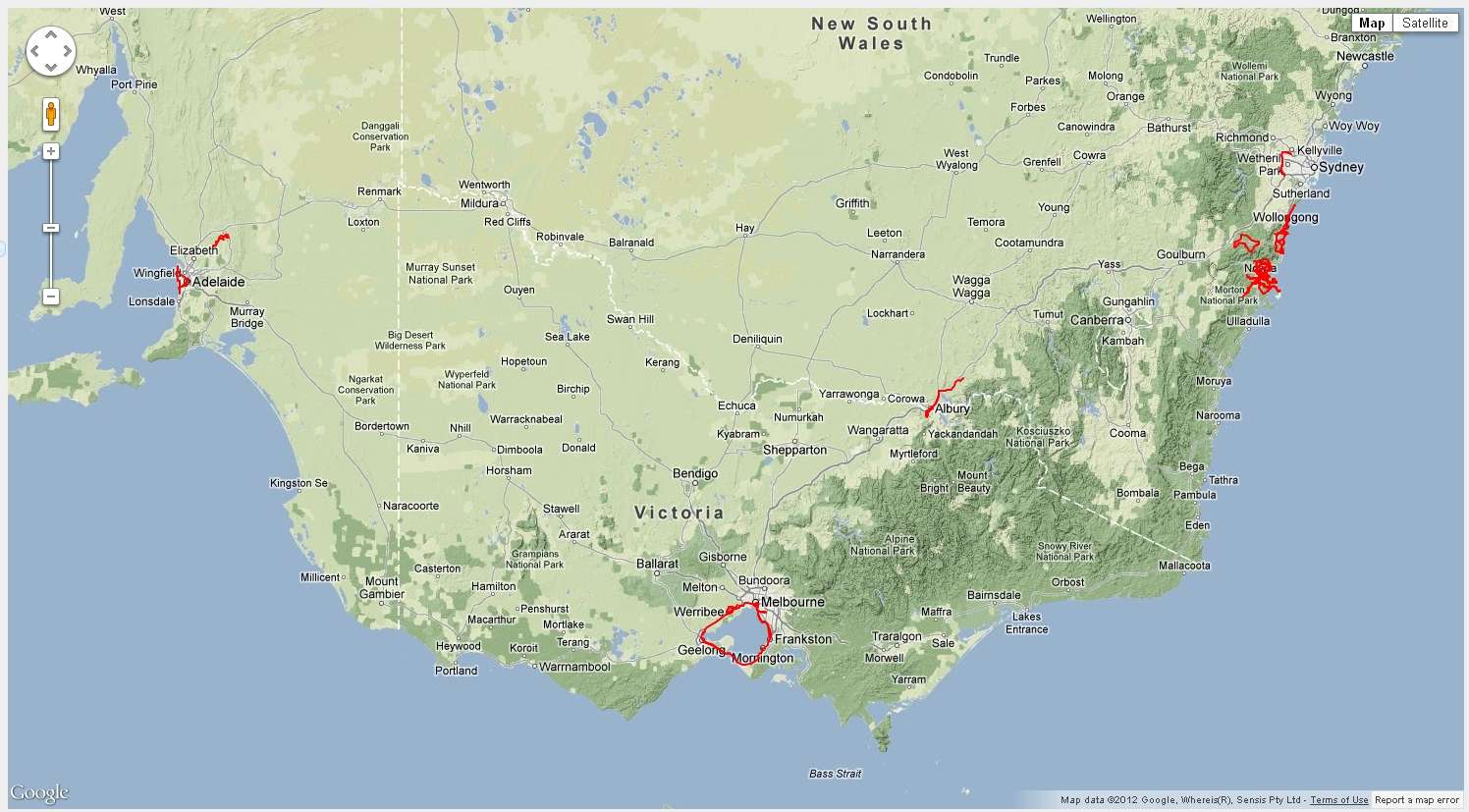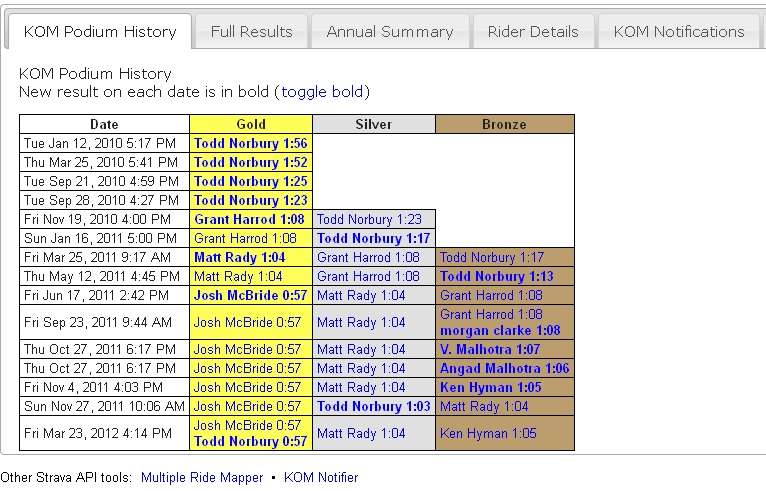A few weeks back I was sent a link to a great website that has a few tools on it to interrogate your Strava rides. The first one I looked at was the Strava Multiple Ride Mapper. It spits out a map of all the rides you have logged on Strava. Below is a shot of my map of rides logged on Strava.
Whilst mucking around with the Ride mapper, I noticed another link at the bottom of the page Segment Details. The information on this page is great.
Not only tables of the top three times, but graphs, amount of times the segment has been ridden, best and average times, the list goes on.
After some time lost looking at segments, I thought I would get in contact with Jonathan and see if he would answer some questions for the blog. He was kind enough to do so.
——————–
NPC :Gday Jonathan (editors note, Jonathan is spelt with an “a” near the end, not “o”. Something he was polite enough to point out later in the interview. My apologies for getting it wrong Jonathan) . Firstly, can you tell us a little bit about yourself?
J.O : I’m a software developer and a road cyclist, living in the Connecticut River valley in western Massachusetts, where we have some great riding — scenic flatlands along the river, and tough hills on either side, including an amazing network of centuries-old dirt roads.
NPC : How long have you been using Strava, and what is your Strava ID so people can follow you?
J.O : My Strava ID is 4497, profile page at http://app.strava.com/athletes/4497. I started using Strava occasionally several years ago, and much more actively once they started allowing unlimited uploads last summer. Close to half the people I ride with are now using Strava, and it’s a great tool to keep informed about what other people are doing out on the road.
NPC : What prompted you to make up the KOM notifier and was it your first Strava project?
J.O : I’ve been collecting and analyzing my ride data for many years using manual tools (log books and spreadsheets). When I started using Strava, it was an obvious choice to replace my manual data collection, but there were some aspects of my manual processes (mapping, in particular) that Strava didn’t do well. Fortunately, Strava offers an extensive API that allows third-parties to build applications to access its data, so I started building a few tools for my personal use to better track my own rides and the segments I was interested in.
Once these became sufficiently polished, I decided to make them available to other Strava users, since they addressed functionality that people had been repeatedly asking about in the help system (in particular, KOM notifications and enhanced segment details).
Since I released the KOM notifier, Strava has implemented its own notification system, and it’s great to now have notifications built into the Strava system without requiring the use of a third-party site like mine. I’ve left my service running, however, since it provides additional features that are not part of the built-in Strava notification service — in particular, the ability to receive notifications for any of the top-ten positions on the leaderboard, not just the KOM, and to receive notifications for changes for any user, not just yourself.
NPC : I only found out about the Multiple Ride Mapper this week (at the time of writing, that was late May), how do you go about promoting your site?
J.O : I’m not really actively promoting the site, since as I mentioned earlier these projects were primarily intended for my own personal use, and I’m not looking to commercialize them. With that said, the tools (in particular the mapping tool) have been getting some notice online over the past couple weeks, which has increased traffic fairly significantly, and I’ve recently put in Facebook/Google+/Twitter buttons to allow people to share the tools with their social networks, which has been fairly effective.
NPC : How difficult is it working with the Strava API?
J.O : It’s not difficult to get started at all. It’s a fairly standard REST API, passing arguments through the request URL and returning a JSON response. There’s also an authentication system that allows users to login and perform certain tasks that are restricted to authorized users, like uploading new rides, but I haven’t used this system yet.
In the early stages there were a few bugs and documented-but-unimplemented features in the API that made some things a little challenging, but Strava has been fairly responsive in getting these fixed, and it’s now quite workable and efficient. There are still a few gaps at the moment (inability to see all rides for a given club, for example, and a restriction that only allows 50 records to be viewed at one time) but I’m hopeful that these can be addressed soon.
NPC : The segment details page is a great tool, do you have any other ideas in the pipeline?
J.O : Yes, I do have a few other ideas that I’ve been thinking about and working on. My tools are currently ride-only (they don’t support runs and other activity types, because Strava originally didn’t make this data available through its API). Apparently you can now get this through the API, so I’d definitely like to add runs and other activities to the segment details and mapping tools.
Strava doesn’t provide a list of all the segments you’ve ridden, which is something many people have asked about. I’ve done some work on this, but the folks at StravaViewer (stravaviewer.com) have put together a really nice interface that shows all the segment information for a user, so that’s a wheel that probably doesn’t need to be reinvented at this point.
I’ve also done some workouts on a Concept2 rowing machine over the past few months. In addition to providing a great workout, these machines store extensive details about your workout, but in a format that is unfortunately incompatible with Strava. I’d like to put together a conversion tool that allows this data to be loaded into Strava, to make it easier to use Strava as a central repository for all types of workouts, cycling and non-cycling related.
NPC : Do you ride often and what sort of bike/s do you own?
J.O : I ride a fair amount, several times a week, but not nearly as far or as fast as most of the folks I ride with. I mostly ride a Trek carbon road bike, but I also got a Surly cross bike last year for dirt-road riding.
NPC : Do you have a favourite segment on Strava?
J. O : Hmm, that’s a tough one. For local climbs, I’d say the climb into Shutesbury, in the hills on the east side of the Connecticut River (http://app.strava.com/segments/608808). This is a scenic, undulating climb with a twisty passage in the middle which is a lot of fun to descend. Further afield, it’s hard to top the monster segment up Mount Washington, the highest point in the northeast United States (http://app.strava.com/segments/3237). This is a 7+ mile grind with a 12% average grade. The KOM at the moment is just over an hour, and with a couple races scheduled there this summer, I expect to see someone turn in a time under an hour this year.
NPC : Thanks for your time Jonathon. I appreciate it
J.O : Likewise, I really appreciate your interest in my work. For what it’s worth, note that the spelling of my name is “Jonathan”
——————————



Great interview norbs!!! I have found both the Multiple Ride Mapper & Segment Details tools well worth a look after you pointed them out to me. I will continue to go back to them for a long time I suspect.
Thanks for the insight Jonathan & keep up the great work. 🙂
Love the screenshot of your rides norbs, the loop around Port Phillip Bay for ATB2011 is very distinctive. 🙂
Pingback: Strava Stuff
Pingback: ExSTRAVAganza. Tools for Strava fanatics | thirstybearcycling.com
I have been using the Mapper for my blog, but the export to KML feature is no longer working. The website can still produce the maps, but if you try to leave a comment or export KML then it fails with a php mysql error. If you still have Jonathan’s contact details can you please let him know because there is no way to contact via his website.